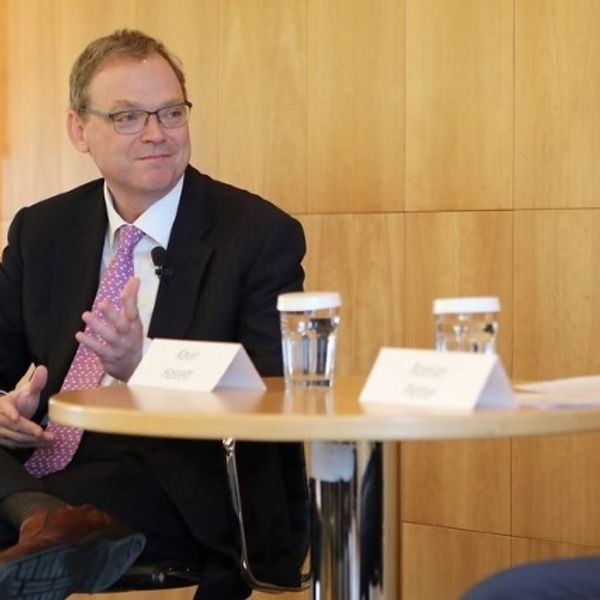
Reprinted with permission from Alternet.
As the Trump administration plans to redirect taxpayer billions to privatize K-12 education, a scholarly article by some of the nation’s leading investigators of charter school rip-offs has highlighted how their business model is prone to fiscal self-dealing.
The article by Preston C. Green, Bruce D. Baker and Joseph O. Oluwole has the dense title, “Are Charter Schools the Second Coming of Enron?: An Examination of the Gatekeepers That Protect Against Dangerous Related-Party Transactions in the Charter School Sector?” But its analysis is striking, comparing corporate management practices at five large schools to the financial shell game that occurred at Enron, the Texas-based energy conglomerate that imploded a dozen years ago.
On the surface, Enron was in the energy business. But behind closed doors, it was engaged in an array of dubious investments and transactions that helped its top executives amass wealth. The charter schools cited in their report similarly present a public face of being alternative public schools. But their founders also used an array of financial tactics, especially involving school real estate deals, to become rich by diverting millions from their classrooms.
Nationwide, 43 states and the District of Columbia have 6,800 charters serving 2.9 million students. They comprise 6 percent of K-12 public school enrollment, which has increased six-fold in the last 15 years. When states approved the first charters in the 1990s, the idea was to nurture locally accountable experimental schools. However, since then a K-12 privatization industry has emerged that is dominated by companies seeking to create regional or national brands, akin to any other corporate franchise. These larger charter operations tend to have non-profit and for-profit arms, which can mask an array of complicated financial relationships.
The charter industry’s largest operations often are run by what’s called educational management organizations, EMOs, which “now control 35-to-40 percent of the industry with an estimated 45 percent of charter students,” the scholars said. These sophisticated operations can attract private investors because they can use their status as schools to get large tax breaks, which, in turn, are applied to a range of profit-making ventures that have nothing to do with educating under-served communities.
“Charter schools attract investors because of the potential for new revenue streams,” the authors said. “For instance, the New Market Tax Credits (NMTC) program provides investors the opportunity to make profits from charter-school real estate transactions. Enacted as a component of the Community Relief Tax Credit Act of 2000, the NMTC was designed to encourage investment in low-income communities. The NMTC accomplishes this goal by providing investors in a community development entity (CDE) a 39% tax credit over a seven-year period.”
But the biggest way to grab seven-figure sums in the privatized education sphere was through shady real estate transactions, they said, saying their for-profit arms can “obtain revenue from charter schools through lease payments for the use of the facilities.” The authors them gave five stunning examples, where the school’s founders could not stop themselves from grabbing millions.
1. Imagine Schools. Imagine Schools is a nonprofit EMO that operates 63 charter school campuses enrolling more than 33,000 students in 11 states and the District of Columbia, they said.
“Imagine Schools uses real estate investment trusts (REITs) and triple net leases for its real estate deals. A REIT is a company ‘that owns and manages property and is required to distribute 90 percent of its income to investors,’” they said. “A triple net lease is a lease agreement whereby the lessee is responsible for rent fees as well as related costs, including taxes, insurance, and facilities maintenance. Thus, triple net leases can be especially costly for charter schools and put a great deal of stress on annual operating expenses.”
They then stated the giant taxpayer rip-off in dry academic terms.
“The rent of charter schools operated by Imagine Schools can be exorbitant,” the authors said. “Many charter schools spend around 14% of their public funding on building rent. By contrast, charter schools run by Imagine Schools spend up to an excessive 40% of their public funding on rent, creating a tight budget for educational necessities, such as textbooks. Thus, these triple net leases can even be more costly to the charter schools in the long run than direct mortgages.”
In other words, 40 percent was stripped off the top before a penny went into classrooms.
2. Ivy Academy. Ivy Academia is a K-12 school with 1,000-plus students in the Los Angeles area founded by Yevgeny Selivanov.
“In April 2013, a California jury convicted Selivanov and his wife and co-founder, Tatyana Berkovich, of felonies and misdemeanors related to their actions as founders,” they wrote.
He was sentenced to five years in prison for an elaborate bait and switch, as explain: “Selivanov and Berkovich were also co-owners of a private preschool, Academy Just for Kids (AJFK), which shared a campus with the charter school. In 2004, AJFK entered into a sublease for that campus at a monthly rent of $18,390. AJFK then assigned the sublease to Alternative, the parent company of Ivy Academia. Alternative assumed responsibility for the monthly rent payments. In 2007, AJFK and Alternative entered into another agreement, which increased the monthly rent from $18,370 to $43,870, even though: (1) the lower amount was the fair market value; (2) the lower rent was valid until 2014; and (3) the original lease prohibited rents from being increased by more than five percent annually.”
Apparently all that wasn’t greedy enough, because these charter operators did what many do—they got their board to rubberstamp and backdate that rent increase.
The academics put it this way: “Selivanov and Berkovich did not present the rent increase to Alternative’s board until October 2008. The board not only approved the rent increase, but it also made the rate effective as of July 1, 2007. As a result, Alternative paid a net rent increase of nearly $238,000.”
3. American Indian Model Charter Schools. The AIMCS is two middle schools and a high school near Oakland, California, with more than 1,100 students. In December 2011, a state oversight agency, California’s Fiscal Crisis Assistance and Management Team (FCMAT), was asked by the county board of education to audit the schools after multiple allegations of fiscal chicanery.
“The agency found that from 2007 to 2011, [Superintendent Ben] Chavis and his wife had received almost $3.8 million in payments from school accounts,” the academics wrote. “Many of these payments were linked to related-party transactions that were, indeed, in violation of the state’s conflict of interest laws.”
The way this worked was a classic example of self-dealing. The charter industry likes to say that it needs to be freed from state regulation so that it can innovate for students. Here the innovation was around shifting taxpayer money into personal accounts. The article cited one example from FCMAT’s audit.
“One transaction involved the Stanford Academic Institute of Learning Summer Mathematics Initiative (SAIL), a privately operated summer program owned by Chavis and a former board member,” they wrote. “SAIL charged the charter schools $500 per student. From the 2009-10 fiscal year through 2011, the charter schools paid SAIL $355,000. FCMAT found that these students were required to attend SAIL, which was in violation of state law.”
And that’s not all. “FCMAT found that AIMS schools paid Chavis’ companies more than $1.5 million for construction improvements,” they said. “Many of these transactions occurred without formal contracts, competitive bidding, or authorization from the charter schools’ governing board.”
4. Michigan’s Grand Traverse Academy. This school, founded by Steven Ingersoll, has 1,300 students from pre-K to 12th grade. This showcased another flavor of extreme self-dealing, where the founder created an EMO that was prepaid a lump sum at the start of the school year. Most of this money went into his pocket until a state auditor discovered this scheme.
“Because of concerns with GTA’s prepayment practices, the [state] charter school’s authorizer requested that a new auditor review the charter school’s books,” the article said. “In 2013, the new auditor found that the charter school had advanced Ingersoll’s management company more than $2.3 million in management fees. That same year, an attorney for GTA sent Ingersoll a demand letter claiming that he owed $3.5 million to the school. Ingersoll tried to repay the debt, but when he fell short by $1.6 million, the board forgave the remaining debt.”
That sad history then repeated itself, the academics said. “Ingersoll sought to repay GTA by taking out a $1.8 million line of credit that he received from a local bank. Ingersoll claimed that he was using that money to convert a church to house another charter school that he had founded. However, he diverted $934,000 of this line of credit into his personal bank account, using some of that money to repay the debt that he owed GTA. In 2015, Ingersoll was convicted of federal tax evasion charges in relation to the church renovation scheme. In 2016, he was sentenced to 41 months in prison.”
5. Pennsylvania Cyber Charter School. This scandal shows that charters don’t even need real property and buildings to bilk public funds. PA Cyber is a virtual, or online, school, which, at its peak, had 11,000 students across the state. Nicholas Trombetta, the founder and former CEO of PA Cyber, also created other firms that did business with PA Cyber. The scholars said one was “National Network of Digital Schools (NNDS), an EMO that provided curriculum and management services to the charter school.”
“An audit of PA Cyber performed by the state auditor general’s office revealed that the charter school paid NNDS more than $153 million from 2011 to 2014, which was almost half of the school’s annual expenditures,” the scholars continued.” In August 2016, Trombetta pleaded guilty to federal tax fraud charges. In his plea,
Trombetta admitted that he and others had transferred $8 million from PA Cyber to other companies controlled by Trombetta, and filed false tax returns to make it seem as though the conspirators received the money, when, in fact, the money went to Trombetta.”
Not Exceptions, But Warning Signs
The scholars said these were not exceptions but red flags in an industry whose business models encouraged a range of self-dealing. The K-12 privatization industry is poised to exponentially expand under the Trump administration as the White House is seeking to shift billions into charters and vouchers, where public funds pay for religious and home schooling. As they wrote:
“One might be tempted to conclude that the examples provided in the prior subpart are mere anecdotes, and that there is thus no cause for concern that unreasonable related-party transactions are widespread. However, it is important to keep in mind that two of the EMOs profiled in this subpart alone, Imagine Schools and PA Cyber, educate a combined 42,000 students. Another industry giant, K12 Inc., has been accused of similar transgressions.
This for-profit EMO is the largest operator of virtual schools in the country. In 2010-11, K12 Inc. enrolled 65,000 students in 48 virtual schools. An exposé of the California Virtual Academies, 10 online schools affiliated with K12 Inc., found that the EMO ‘effectively controls the schools by providing them with all academic services.’ According to accounting experts who analyzed the management services agreements, it was ‘tough to tell where the nonprofit ends and where the company begins.’”
“Tough to tell” where the non-profit and for-profit worlds blur is an apt warning for the coming wave of K-12 privatization under Trump. But what’s clear and not blurry is that these large and ambitious K-12 franchises are not always about educating kids. They’re about getting rich off taxpayers and calling that public education
Steven Rosenfeld covers national political issues for AlterNet, including America’s democracy and voting rights. He is the author of several books on elections and the co-author of Who Controls Our Schools: How Billionaire-Sponsored Privatization Is Destroying Democracy and the Charter School Industry (AlterNet eBook, 2016).
This article was made possible by the readers and supporters of AlterNet.








